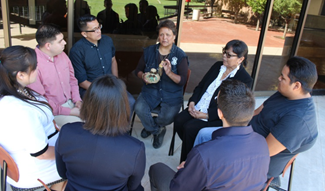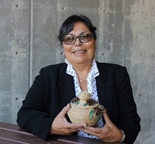SILC combines Native American traditions and restorative justice to help clients
March 31, 2016 - Tamara Williams

The Southwest Indian Law Clinic is using a process called Circles of Peace that combines Native American traditions and restorative justice to resolve disputes and create pathways for healing.
The UNM Law School’s Southwest Indian Law Clinic (SILC) combines Native American traditions and restorative justice to help Native clients in state, federal, and tribal courts and in governmental agency hearings.
Visiting Professor Cheryl Demmert Fairbanks (Alaska Native, Tlingit-Tsimpshian) is one of the leading experts on Peacemaking and Tribal Restorative Justice, a form of justice that emphasizes repairing the harm done by a crime and creating pathways for healing through cooperative processes with all stakeholders.
She and the students in SILC are using a process called Circles of Peace in class. They also use it for family conferencing with their clients.
“Circles of Peace emphasizes respect, listening, and collective decision-making,” says Fairbanks. “Often the process is therapeutic and provides the family with the tools necessary to start the healing process.”
SILC students act as coordinators for a family conference with clients. They gather the immediate family and extended family members, as well as interested parties, such as counselors, social workers, or neighbors, gather together in a neutral space and form a circle.

Professor Cheryl Fairbanks holds a basket she uses as a tool for Circles of Peace.
The coordinator opens the meeting with a prayer and a moment of silence. Then he or she outlines the process for the conference and the rules, including listening, showing respect, and being “tough on the issue, gentle on the person.”
An object such as a basket or pottery serves as a microphone and a talking tool and is passed around the circle, emphasizing respect for self and others, as well as the importance of listening.
After everyone has spoken, the group discusses solutions and collectively decides on an action plan. Later, a Family Safety and Wellness Agreement is drawn up by SILC and signed by the family members.
Fairbanks says that family conferencing allows a shift from conflict to collaboration, consensus and coherence within the family, and ultimately, within the community.
Fairbanks and her SILC students are using Circles of Peace to help clients in tribal courts resolve a wide variety of cases, including domestic violence, child custody, probate issues, trespassing and more.
Associate Dean for Indian Law Christine Zuni Cruz says, “The circle shifts the dynamic, whether it is in the classroom, the courtroom or the community. It is an important tool for teaching, healing and engaging the community.”

